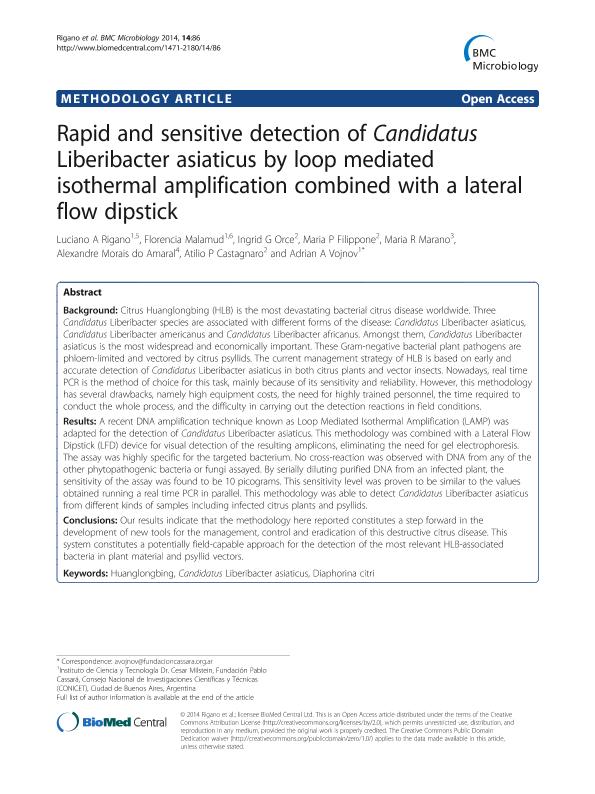Mostrar el registro sencillo del ítem
dc.contributor.author
Rigano, Luciano Ariel
dc.contributor.author
Malamud, Florencia

dc.contributor.author
Orce, Ingrid Georgina

dc.contributor.author
Filippone, María Paula

dc.contributor.author
Marano, Maria Rosa

dc.contributor.author
Do Amaral, Alexandre Morais
dc.contributor.author
Castagnaro, Atilio Pedro

dc.contributor.author
Vojnov, Adrian Alberto

dc.date.available
2016-04-19T16:07:42Z
dc.date.issued
2014-03
dc.identifier.citation
Rigano, Luciano Ariel; Malamud, Florencia; Orce, Ingrid Georgina; Filippone, María Paula; Marano, Maria Rosa; et al.; Rapid and sensitive detection of Candidatus Liberibacter asiaticus by loop mediated isothermal amplification combined with a lateral flow dipstick; Biomed Central; Bmc Microbiology; 14; 86; 3-2014; 1-9
dc.identifier.issn
1471-2180
dc.identifier.uri
http://hdl.handle.net/11336/5282
dc.description.abstract
Background: Citrus Huanglongbing (HLB) is the most devastating bacterial citrus disease worldwide. Three Candidatus Liberibacter species are associated with different forms of the disease: Candidatus Liberibacter asiaticus, Candidatus Liberibacter americanus and Candidatus Liberibacter africanus. Amongst them, Candidatus Liberibacter asiaticus is the most widespread and economically important. These Gram-negative bacterial plant pathogens are phloem-limited and vectored by citrus psyllids. The current management strategy of HLB is based on early and accurate detection of Candidatus Liberibacter asiaticus in both citrus plants and vector insects. Nowadays, real time PCR is the method of choice for this task, mainly because of its sensitivity and reliability. However, this methodology has several drawbacks, namely high equipment costs, the need for highly trained personnel, the time required to conduct the whole process, and the difficulty in carrying out the detection reactions in field conditions.
Results: A recent DNA amplification technique known as Loop Mediated Isothermal Amplification (LAMP) was adapted for the detection of Candidatus Liberibacter asiaticus. This methodology was combined with a Lateral Flow Dipstick (LFD) device for visual detection of the resulting amplicons, eliminating the need for gel electrophoresis. The assay was highly specific for the targeted bacterium. No cross-reaction was observed with DNA from any of the other phytopathogenic bacteria or fungi assayed. By serially diluting purified DNA from an infected plant, the sensitivity of the assay was found to be 10 picograms. This sensitivity level was proven to be similar to the values obtained running a real time PCR in parallel. This methodology was able to detect Candidatus Liberibacter asiaticus from different kinds of samples including infected citrus plants and psyllids.
Conclusions: Our results indicate that the methodology here reported constitutes a step forward in the development of new tools for the management, control and eradication of this destructive citrus disease. This system constitutes a potentially field-capable approach for the detection of the most relevant HLB-associated bacteria in plant material and psyllid vectors.
dc.format
application/pdf
dc.language.iso
eng
dc.publisher
Biomed Central

dc.rights
info:eu-repo/semantics/openAccess
dc.rights.uri
https://creativecommons.org/licenses/by/2.5/ar/
dc.subject
Huanglongbing
dc.subject
Candidatus Liberibacter Asiaticus
dc.subject
Diaphorina Citri
dc.subject
Detection by Lamp
dc.subject.classification
Tecnología GM, clonación de ganado, selección asistida, diagnósticos, tecnología de producción de biomasa, etc.

dc.subject.classification
Biotecnología Agropecuaria

dc.subject.classification
CIENCIAS AGRÍCOLAS

dc.title
Rapid and sensitive detection of Candidatus Liberibacter asiaticus by loop mediated isothermal amplification combined with a lateral flow dipstick
dc.type
info:eu-repo/semantics/article
dc.type
info:ar-repo/semantics/artículo
dc.type
info:eu-repo/semantics/publishedVersion
dc.date.updated
2016-05-06 15:52:43.262787-03
dc.journal.volume
14
dc.journal.number
86
dc.journal.pagination
1-9
dc.journal.pais
Reino Unido

dc.journal.ciudad
Londres
dc.description.fil
Fil: Rigano, Luciano Ariel. Consejo Nacional de Investigaciones Científicas y Técnicas. Oficina de Coordinación Administrativa Parque Centenario. Instituto de Ciencias y Tecnología "Dr. Cesar Milstein"; Argentina. University of Otago. Department of Microbiology and Immunology; Nueva Zelanda
dc.description.fil
Fil: Malamud, Florencia. Consejo Nacional de Investigaciones Científicas y Técnicas. Oficina de Coordinación Administrativa Parque Centenario. Instituto de Ciencias y Tecnología "Dr. Cesar Milstein"; Argentina. Consejo Nacional de Investigaciones Científicas y Técnicas. Oficina de Coordinación Administrativa Parque Centenario. Instituto de Investigaciones Fisiológicas y Ecológicas Vinculadas a la Agricultura; Argentina
dc.description.fil
Fil: Orce, Ingrid Georgina. Instituto de Tecnología Agroindustrial del Noroeste Argentino. Estación Experimental Agroindustrial Obispo Colombres; Argentina
dc.description.fil
Fil: Filippone, María Paula. Instituto de Tecnología Agroindustrial del Noroeste Argentino. Estación Experimental Agroindustrial Obispo Colombres; Argentina
dc.description.fil
Fil: Marano, Maria Rosa. Consejo Nacional de Investigaciones Científicas y Técnicas. Centro Científico Tecnológico Rosario. Instituto de Biología Molecular y Celular de Rosario; Argentina
dc.description.fil
Fil: Do Amaral, Alexandre Morais. Ministerio Da Agricultura Pecuaria E Abastecimento de Brasil. Empresa Brasileira de Pesquisa Agropecuaria; Brasil
dc.description.fil
Fil: Castagnaro, Atilio Pedro. Instituto de Tecnología Agroindustrial del Noroeste Argentino. Estación Experimental Agroindustrial Obispo Colombres; Argentina
dc.description.fil
Fil: Vojnov, Adrian Alberto. Consejo Nacional de Investigaciones Científicas y Técnicas. Oficina de Coordinación Administrativa Parque Centenario. Instituto de Ciencias y Tecnología "Dr. Cesar Milstein"; Argentina
dc.journal.title
Bmc Microbiology

dc.relation.alternativeid
info:eu-repo/semantics/altIdentifier/url/http://bmcmicrobiol.biomedcentral.com/articles/10.1186/1471-2180-14-86
dc.relation.alternativeid
info:eu-repo/semantics/altIdentifier/url/http://www.ncbi.nlm.nih.gov/pmc/articles/PMC4021466/
dc.relation.alternativeid
info:eu-repo/semantics/altIdentifier/doi/10.1186%2F1471-2180-14-86
dc.relation.alternativeid
info:eu-repo/semantics/altIdentifier/doi/http://dx.doi.org/10.1186%2F1471-2180-14-86
Archivos asociados
